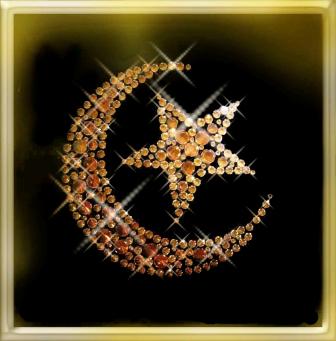The Crescent Moon. Is it a Symbol of Islam?

The crescent moon and star is an internationally-recognized symbol of the faith of Islam. The symbol is featured on the flags of several Muslim countries, and is even part of the official emblem for the International Federation of Red Cross and Red Crescent Societies. The Christians have the cross, the Jews have the star of David, and the Muslims have the crescent moon, right?
What is the history behind the crescent moon symbol? What does it symbolize or mean? How and when did it become associated with the faith of Islam? Is it a valid symbol for the faith?

The crescent moon and star symbol actually pre-dates Islam by several thousand years. Information on the origins of the symbol are difficult to ascertain, but most sources agree that these ancient celestial symbols were in use by the peoples of Central Asia and Siberia in their worship of sun, moon, and sky gods. There are also reports that the crescent moon and star were used to represent the Carthaginian goddess Tanit or the Greek goddess Diana.
The city of Byzantium (later known as Constantinople and Istanbul) adopted the crescent moon as its symbol. According to some reports, they chose it in honor of the goddess Diana. Others indicate that it dates back to a battle in which the Romans defeated the Goths on the first day of a lunar month. In any event, the crescent moon was featured on the city's flag even before the birth of Christ.
The early Muslim community did not really have a symbol. During the time of the Prophet Muhammad (peace be upon him), Islamic armies and caravans flew simple solid-colored flags (generally black, green, or white) for identification purposes. In later generations, the Muslim leaders continued to use a simple black, white, or green flag with no markings, writing, or symbolism on it.
It wasn't until the Ottoman Empire that the crescent moon and star became affiliated with the Muslim world. When the Turks conquered Constantinople (Istanbul) in 1453, they adopted the city's existing flag and symbol. Legend holds that the founder of the Ottoman Empire, Osman, had a dream in which the crescent moon stretched from one end of the earth to the other. Taking this as a good omen, he chose to keep the crescent and make it the symbol of his dynasty. There is speculation that the five points on the star represent the five pillars of Islam, but this is pure conjecture. The five points were not standard on the Ottoman flags, and as you will see on the following page, it is still not standard on flags used in the Muslim world today.
For hundreds of years, the Ottoman Empire ruled over the Muslim world. After centuries of battle with Christian Europe, it is understandable how the symbols of this empire became linked in people's minds with the faith of Islam as a whole.
Based on this history, many Muslims reject using the crescent moon as a symbol of Islam. The faith of Islam has historically had no symbol, and many refuse to accept what is essentially an ancient pagan icon. It is certainly not in uniform use among Muslims.
Source: http://islam.about.com/od/history/a/crescent_moon.htm
The American Muslim scholar, Sheik Yusuf Estes, Director of islamtomorrow.com, and National Chaplain WAMY, adds:
“The symbol of Islam IS NOT the crescent moon and the star, but it was used by the last Islamic Dynasty, the Ottoman’s. The Ottoman Empire deemed it appropriate to use the star and crescent as their symbols, but not the symbols of Islam. I repeat, the star and the crescent moon are not a part of the religion of Islam. Because Islam is so strict on the concept of no other gods with Allah; and no images of any kind; it is a mistake to consider that Islam authorized the general use of such things. Additionally, Islam forbids the images (statues) of any kinds of humans, animals or any of Allah’s creations, so how about using a symbol for Islam?”
Allah Almighty knows best.